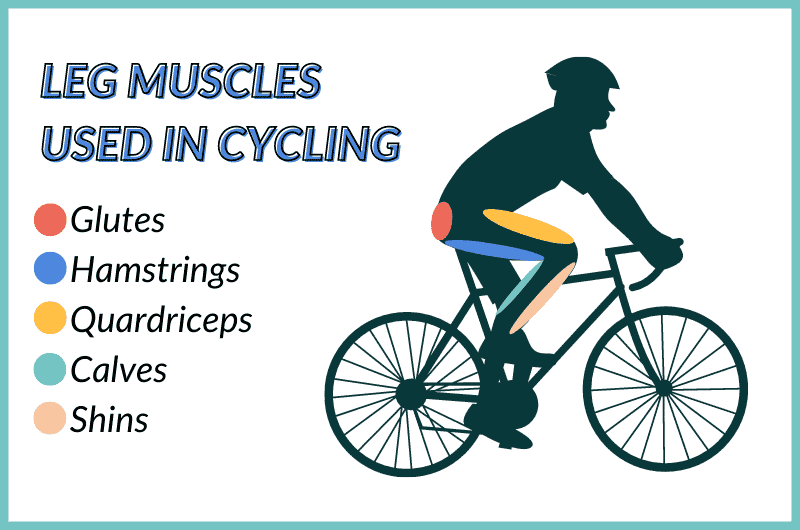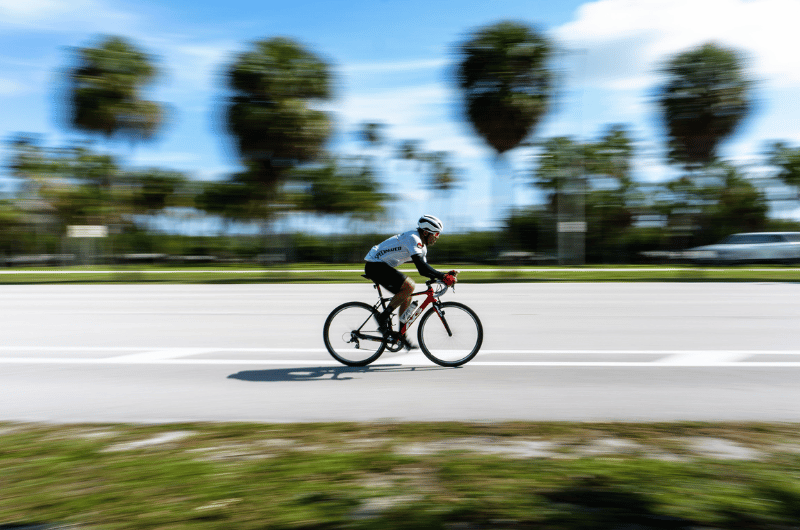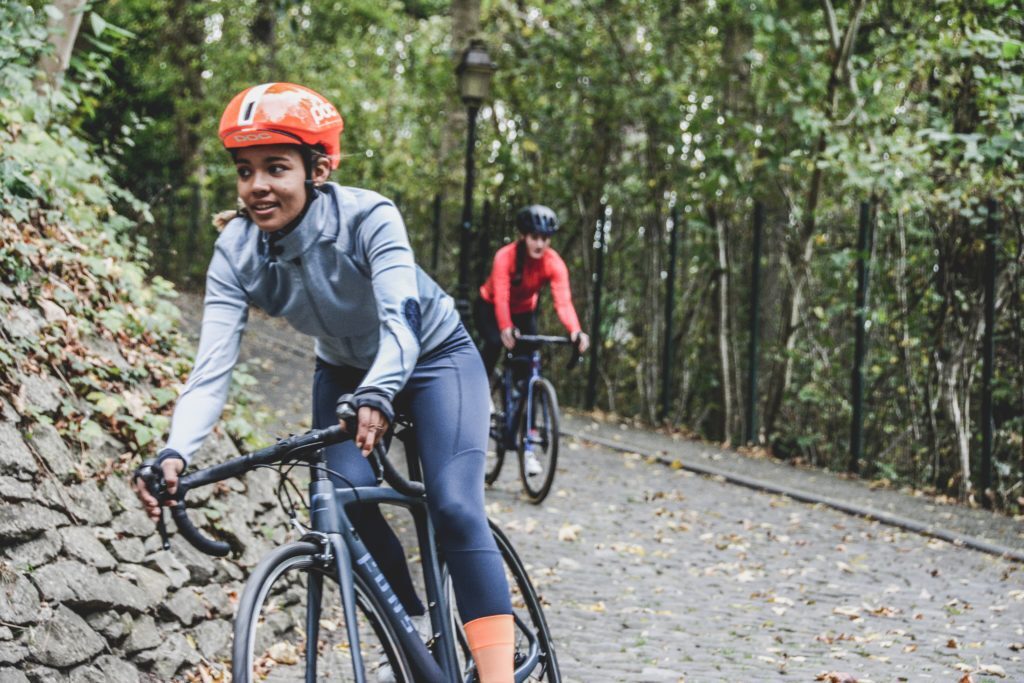Cycling is well known to provide physical and mental health benefits. Overall wellbeing is helped by a positive boost to your mind, body and soul. Focusing on the body workout part, cycling is an aerobic, resistance activity which tones your core and lower muscles. Your arms get a workout too.
What Muscles Are Worked While Cycling?
The main muscles activated while cycling are below the waist, but we also derive some benefit to the core and arms. Our power comes mainly from the glutes, the quadriceps, the calves, the hamstrings and the hip flexors. Balance and stability to deliver the power works the biceps, triceps and abs.
No two people are the same but this guide puts forward a template to the way the different muscles are used. You’ll need to think of a right pedal stroke as a circular clock face, going in the opposite direction for the left pedal stroke.
The glutes, which you use to sit, produce around 27% of the power when pedalling and are working hardest at the top of the pedal stroke. Your quadriceps run along the front of the leg from hip to knee. They give you 39% of your pedal power and are working hardest as each right pedal stroke goes from 2 o’clock to 6 o’clock.
Your calves produce around 20% of the effort needed and are working hardest from 6 o’clock to 9 o’clock. The hamstrings give you 10% of the power as you swing the pedal back up to 9 o’clock. Finally, getting you back to 12 o’clock requires the hip flexors, which give you the final 4% of your power.
Is Cycling Good for Muscle Toning?
Cycling is great for muscle toning – and you can start at at any age. This aerobic exercise is a form of resistance training, working the endurance muscles. These are sometimes referred to as ‘slow-twitch’ muscles. These are generally leaner and working them creates a narrower profile.
‘Fast-twitch’ muscles are needed for strength training and bursts of power. Their size is increased by working with weights. Most of us will have a 50:50 split of fast and slow twitch muscles but regular commuting and leisure cycling will most likely develop more of the slow twitch version.
The intensity of your riding style marks a difference between muscle growth and muscle toning. One way to check the intensity of your riding is to get to grips with your maximum heart rate. There are lots of ways to check this but the most cost-effective is to subtract your age from 220, as this measurement suggests.
This study suggests that in younger adults who are new to regular physical exercise, muscles will grow when the intensity of the exercise is performed at 75%-85% of the maximum heart rate. This is considered the more vigorous end of the activity scale – you’ll be out of breath and not likely to keep up a regular conversation as you ride.
If you don’t push yourselves to this level, your muscles will more likely be toned, and less bulky. The endurance muscle fibres you work are also more resistant to becoming tired, which will boost your morale for more riding. There’s a lot of changes going on in the body at once when you cycle, as we discover here.
Cycling is very-low impact compared to running and walking – the turning motion and seater position puts less pressure on the muscles. The rate of muscle damage is lower, nearly half as low as running. Something called DOMS (delayed onset muscle soreness) is lower too.
This is crucial. It normally starts a day or two after the workout and keeping it at bay or in the background will boost your motivation for consistent exercising.

Effect of Cycling on Body Shape
Body shape is likely to change as a result of cycling, but more so in conjunction with other amended lifestyle aspects . Aerobic exercise burns calories. Only 25% of body shape changes come from cycling alone. The other 75% will come from diet. The noticeable effects will be different to your partner, cycling friends or fellow commuters.
No two bodies are the same and perhaps we have different exercise goals. Cycling to work, as we examine here, is likely to work the muscles less than if we were a member of a cycling club doing really intensive training. But they will be working the same muscles.
Gyms have included exercise bikes as an essential part of their kit for decades. That’s a sign of the good that comes from turning pedals. There are benefits for your cardiovascular system, as we examine here.
There are generally considered to be three types of body shape, as we see here. These are endomorph (more body fat and less muscle), mesomorph (relative solid shape, more muscle than fat) and ectomorph (lean build, less natural muscle than a mesomorph). The body type plays a huge part in determining body shape. Cycling will impact the body shape of each, just in different ways.
It would be expected that one month of regular bicycle riding would start to provide you with visible results. Lifestyle, diet and the frequency of exercise will make a huge difference to the rate at which you see improvements. Regular, short rides, like commuting, should burn 1,000 calories per week. Riding at 12 miles per hour might see you burn over 500 calories in 60 minutes. There’s more information here.
There are ways to burn more calories and build muscles without a significant change to routines. Including more elevated roads in your riding will mean increased effort and burn more calories.
The extra effort will target your upper arms and core muscles as well because you pull on the handlebars a little more and, providing it’s safe, you may even stand up while pedalling to shift the emphasis onto muscles in the core and thighs.
Your cadence (or the number of times you revolve your pedals per minute) will influence how toned your muscles become. More fat will be burned if you can manage 90-110 revolutions per minute. This might mean some experimentation with gears and less time ‘freewheeling’ but you’ll be leaner than if you cycle at a lower cadence, as this increases resistance and builds more bulk.

Does Cycling Tone Your Stomach?
Cycling burns fat in the body and should produce results that will tone the stomach. If you laid 5kg of fat out and did the same for muscle, the profile and mass simply takes up less area. It’s a pretty gross image but muscle is much leaner than fat. Your core gets a workout which builds muscle too.
As you ride, even though you are seated, your core is working to keep the body balanced and centred on the bicycle. A good core is vital for efficient pedalling and your body tends to find the most effective way of turning the pedals. Toning mainly comes from burning the fat, however.
Does Cycling Tone Your Legs?
Cycling will tone your legs when you work at a medium intensity. If you start to work intensively and powerfully – with increased heart rate and really forcing your legs by pedalling in a really high gear and low cadence, you’ll see bulk replacing tone. Resistance will build more noticeable muscle.
There’s less stress involved in cycling at a higher cadence – turning the pedals more quickly – than grinding at a lower cadence. One example of tone v muscle is to compare images of the legs of an Olympic track cyclist and an Olympic road cyclist. Same sport but one generally requires powerful surges over short distances and times compared to the other, which require more sustained periods of endurance.
Track cyclists do use weights to grow their muscles which enhances development, but the principles are true.

Does Cycling Tone “Thighs and Bum”?
Cycling will tone the legs and seated muscles. Fat contained there will degrade and deplete after regular workouts. Exercise increases the metabolism which helps reduce muscle mass quicker. Varying the cadence may hasten this process a bit. Results do take time for different body shapes and sizes.
The post What Muscles Does Cycling Tone? [ANALYSIS] appeared first on Discerning Cyclist.
![What Muscles Does Cycling Tone? [ANALYSIS]](http://bicycle.org/wp-content/uploads/2022/07/Copy-of-diamond-frame-parts-760x504.png)